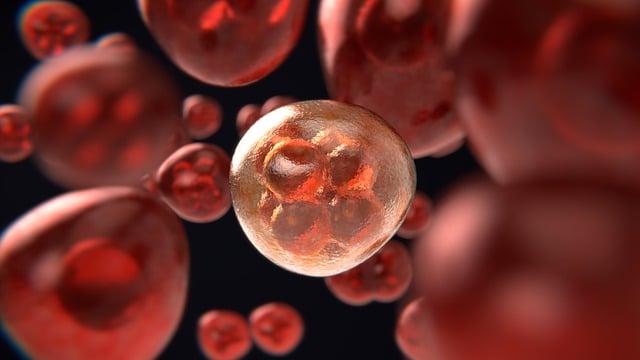Stem cell culture media is crucial for producing high-quality supplements, providing essential nutrients for efficient cell proliferation, cryopreservation, and differentiation. Creating it requires meticulous selection of components, including growth factors, to optimize cell growth and maintain consistent quality. Standardization ensures uniform protocols, such as xeno-free and pyrogen-free media, adhering to strict quality control. This advanced approach facilitates reliable research outcomes and efficient mesenchymal stem cell harvests. Navigating regulatory guidelines is essential for marketing high-quality media while meeting safety standards. Future trends include developing xeno-free systems, precise pH adjustments, and serum-free mediums to enhance ethical practices and cellular functionality in stem cell culture.
“Explore the transformative power of high-quality culture supplements, built upon the bedrock of understanding stem cell culture media. This comprehensive guide delves into the intricate process of crafting optimal growth formulations, emphasizing consistency through standardization and quality control measures. From groundbreaking research applications to navigating regulatory landscapes, uncover the potential of these advanced supplements while peering into emerging trends shaping the future of stem cell culture media.”
- Understanding Stem Cell Culture Media: The Foundation of Quality Supplements
- Components and Formulas: Crafting the Perfect Blend for Optimal Growth
- Ensuring Consistency: Standardization and Quality Control Measures
- Applications in Research and Therapy: Unlocking the Potential of High-Quality Supplements
- Regulatory Considerations: Navigating Guidelines for Safety and Efficacy
- The Future of Stem Cell Culture Media: Innovations and Emerging Trends
Understanding Stem Cell Culture Media: The Foundation of Quality Supplements

Stem cell culture media forms the bedrock upon which high-quality supplements are built. This specialized nutrient-rich formula provides the essential components required for efficient stem cell proliferation, a crucial step in ensuring the purity and potency of supplements derived from these cells. The composition of this media is meticulously crafted to support not just stem cell expansion and cryopreservation, but also to maintain optimal conditions for their differentiation into various cell types.
Key to achieving consistent quality is understanding that stem cell culture media must offer a balanced environment. This includes the precise combination of defined components, growth factors, and supplements necessary to sustain cells in an undifferentiated state while facilitating controlled expansion. By carefully controlling these variables, manufacturers can produce supplements with predictable results, ensuring every batch meets the rigorous standards set for high-quality healthcare products.
Components and Formulas: Crafting the Perfect Blend for Optimal Growth

Creating high-quality culture supplements involves meticulous attention to detail in selecting and combining components. Stem cell culture media, for instance, requires a precise balance of chemically defined stem cell growth factors and defined stem cell media components to ensure optimal cell proliferation and differentiation. These carefully curated ingredients mimic the natural environment necessary for stem cells to thrive, facilitating their maintenance and expansion for various applications.
The art lies in achieving media optimization for clinical-grade stem cells, where each component is meticulously chosen based on its effectiveness and purity. This process involves a deep understanding of stem cell biology and the specific needs of different cell types. By combining these optimized components, researchers can create an environment that not only supports robust growth but also ensures consistent quality and functionality of the generated stem cells.
Ensuring Consistency: Standardization and Quality Control Measures

Maintaining consistency in stem cell culture is paramount to ensuring reliable research outcomes and product quality. Standardization involves establishing uniform protocols for preparing and maintaining specialized media, such as xeno-free and pyrogen-free stem cell media, which are crucial for animal-component-free stem cell culture protocols. This meticulous approach ensures that every batch of stem cell media produced adheres to strict quality control measures, minimizing variability and enhancing reproducibility.
By implementing rigorous standardization practices, researchers can confidently rely on the consistent composition and stability of their stem cell culture media. This, in turn, facilitates precise experimental control and promotes the development of reliable, high-quality stem cell products, ultimately advancing research and therapeutic applications.
Applications in Research and Therapy: Unlocking the Potential of High-Quality Supplements

High-quality supplements derived from advanced stem cell culture techniques have opened up exciting possibilities in both research and therapeutic applications. These cutting-edge alternatives to traditional fetal bovine serum (FBS) in stem cell culture offer numerous advantages. Researchers can now explore a wide range of options, ensuring more consistent and predictable results in their experiments. The use of specialized media for efficient mesenchymal stem cell harvest has streamlined the process, making it easier to obtain pure and viable cells for research and clinical purposes.
Stem cell media stability testing is another critical aspect that contributes to the success of these supplements. By ensuring the media remains stable, researchers can maintain optimal cell growth conditions over extended periods. This is particularly essential when studying long-term effects or conducting in vitro studies mimicking in vivo environments. The availability of high-quality stem cell culture media has revolutionized research, enabling scientists to unlock the full potential of stem cells and their applications in various therapeutic fields.
Regulatory Considerations: Navigating Guidelines for Safety and Efficacy

Navigating regulatory guidelines is an essential step in the development and marketing of high-quality culture supplements, particularly for stem cell culture media. The field of stem cell research is highly regulated to ensure safety and ethical practices due to the sensitive nature of these cells. Regulatory bodies worldwide have established stringent standards to govern the production and utilization of stem cell media to safeguard both consumers and researchers.
When developing xeno-free stem cell culture systems, manufacturers must consider various factors, including media composition, stability testing, and compatibility with different cell types. Ethical considerations in media selection play a pivotal role, as certain components may raise concerns regarding animal-derived materials or potential contaminants. Therefore, rigorous testing is required to ensure the purity and consistency of stem cell media, meeting the regulatory requirements for both safety and efficacy.
The Future of Stem Cell Culture Media: Innovations and Emerging Trends

The future of stem cell culture media is looking bright with continuous innovations and emerging trends transforming the way we support cellular growth. Researchers are increasingly focusing on developing xeno-free stem cell culture systems, eliminating potential contamination risks associated with animal products. This shift towards more ethical and safer alternatives is driving the adoption of advanced formulations that replicate natural microenvironments.
Moreover, precision adjustments in stem cell media pH balance are gaining traction as a key strategy to optimize cellular functionality. By fine-tuning the pH levels, scientists can create conditions that foster ideal stem cell growth, enhancing differentiation capabilities and overall health. Additionally, serum-free stem cell growth medium is becoming a preferred choice for many labs due to its ability to provide consistent, defined, and robust support for long-term maintenance and expansion of these versatile cells.
Stem cell culture media is a multifaceted field that combines scientific precision with innovative formulations. By understanding the foundational elements, crafting precise blends, and adhering to rigorous quality control, we can unlock the immense potential of these supplements in both research and therapeutic applications. As the industry evolves, navigating regulatory guidelines and embracing emerging trends will be crucial to ensure safety, efficacy, and continued progress in the realm of stem cell culture media.














